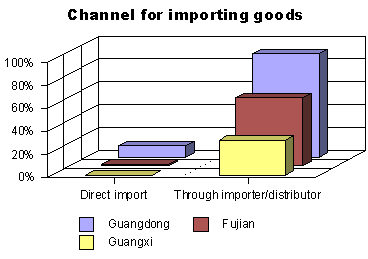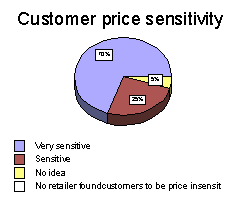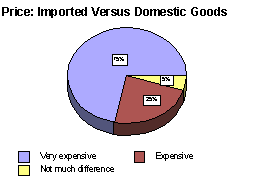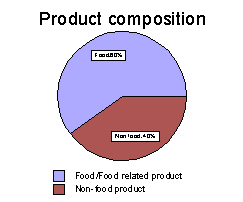

South China Retail Food Market Report
March 2002
Canadian Consulate General
Guangzhou, China
For many countries in the world, Year 2001 was just another difficult year of struggle: political unrest, discontent of the masses, economic downturns, collapse of big companies, high unemployment, etc. However, looking to the east and despite the global economic slowdown, China, a country with a huge population of 1.3 billion, still enjoyed a GDP growth of 7.3 % in 2001. As GDP hit US$1.16 trillion, imports and exports reached US$510 billion, an increase of 7.5 percent over the previous year. In 2001, China also successfully hosted the Ninth APEC Economic Leaders Meeting and other major international conferences. Its capital city, Beijing, won in its bid to host the 2008 Olympic Summer Games. All this indicates that China continues to raise its international status and expand its influence in international affairs.
More important, after fifteen years of effort, China became a member of the World Trade Organization at the end of 2001. What this means to China and the world at large can neither be predicted nor be described by words alone. However, what should be of interest to Canadian exporters are China's commitments to the WTO, in particular, tariff cuts. Beginning this year (2002), China has cut its average tariff rate levels on 5,000 imported goods from 15.3 percent to 12 percent. The average tariff rate on agricultural products, excluding aquatic products, has been lowered to 15.8 percent in 2002. The average tariff rate on aquatic products has been reduced to 14.3 percent. China also has cancelled quota licences on grain, wool, cotton, fertilizer and some other goods. Under its WTO commitments, China will cut average tariff levels on all imported products to about 10 percent by 2005.
According to the China State Economic and Trade Commission (SETC), the volume of retail sales of consumer goods totalled about US$ 453.9 billion in 2001, up 10 percent from the previous year's figure. Statistics also show that China's domestic demand expanded 9.2 percent in 2001, contributing 43 percent to the GDP growth. In fact, China's consumer goods retail sales have risen an average of 10.6 percent annually during the 10th Five-Year Plan period (1996-2000).
As one of the most important and powerful economic strengths in Chinese Mainland, the South China region offers better performance than most other provinces of the country. Comprising the four provinces of Guangdong, Guangxi, Fujian and Hainan, the South China region has a population of 175 million (13.5 percent of China's total). It includes all of the five original SEZs (special economic zones) in China: Shenzhen, Zhuhai, Shantou, Xiamen and Hainan Island.
Within these four provinces, Guangdong, with a population of 87 million, plays an important role in China's market economy. In 2001, the foreign trade volume in Guangdong Province amounted to about US$176.5 billion, accounting for about 35% of China's total. During the last decade(1991-2000), Guangdong's annual economic growth rate was 13%. In 2001, the GDP growth rate was 9.5 percent, hitting US$127.5 billion, and accounting for 11 percent of China's total. Guangdong also has a geographical advantage: it is the only Chinese province that shares a border with Hong Kong and Macau.
As the capital city of Guangdong Province, Guangzhou has long been recognized as the Grand South Gate of China. Due to its geographic proximity to Hong Kong, and China's open-door policy since 1979, Guangzhou has become a very strong economic force both in Guangdong Province and the rest of China, and the central city of South China. In 2001, its GDP growth rate was 12.5 percent, 5.2 percent higher than the country's average level.
Investment-attracting Fujian Province, situated on the southeast China coast, is separated from Taiwan, the largest island in China by only a 180-km strait. It has a population of 35 million; its capital city is Fuzhou. Xiamen, another major city in the province, is also one of the five SEZs in China. In 2001, Fujian's GDP growth reached 9 percent, which is 1.7 percent higher than the country's average. Its Foreign Direct Investment (FDI) was US $4 billion.
Resource and tourism rich Guangxi Zhuang Autonomous Region borders Guangdong Province to the west. It has a population of 45 million; its capital city is Nanning. In 2001, the GDP growth rate was 8.2 percent, about 1 percent higher that the country's average. The volume of foreign trade reached US$ 1.8 billion. Other major cities in Guangxi include Beihai, Guilin and Liuzhou.
The above information indicates that the South China region is a market that Canadian exporters cannot and should not ignore. As more and more Canadian companies have begun to penetrate the South China market, the need to access major retail food industry players became a necessity. The Canadian Consulate General in Guangzhou, with support from Agriculture and Agri-food Canada (AAFC), conducted a market survey in the three South China provinces of Guangdong, Fujian and Hainan by visiting a selection of major supermarkets/ hypermarkets/chain-stores in the cities of Guangzhou, Shenzhen, Fuzhou, Xiamen, and Nanning. In order to ensure consistency of information collected, interviews with retailers, some personal and some through phone conversations, were done by asking similar questions. Some retailers, e.g., Wal-Mart, declined requests for interviews, therefore relative information had to be obtained through other possible channels, i.e., third party contacts, or onsite tours. Generally speaking, the information collected was first-hand and is considered reliable. However, it is intended for reference only. The Government of Canada cannot and does not guarantee the accuracy of any of the information contained in this report, nor does it necessarily endorse the organizations listed herein.
Following are the questions raised in the interviews followed by a brief summary/analysis of the information received. All charts illustrated in this report were created based on the information collected.
1. What do you import; from which countries or suppliers; and in what quantity?
The answers were surprisingly similar. Almost all retailers said that they didn't do direct importation. The reasons were: firstly, before China's accession to the WTO, it was virtually impossible and/or very difficult to obtain an import/export licence, particularly by privately-owned companies. Only select state-owned enterprises (SOEs) held privileges to import. Now that China has officially become a WTO member. It is getting easier to apply for import/export status. However, according to the survey, less than 10% of the retailers expressed the desire to apply for such a licence. Instead most preferred dealing with importers/distributors, out of concern for after-sale service of imported products. Most felt that if they bought goods directly from a foreign exporter, should customers complain about the quality /service, it would be difficult and inconvenient to contact foreign exporters for a satisfactory solution. Besides, many well-known foreign enterprises have set up joint ventures/ subsidiaries/representative offices in China, which can be easily contacted, if required. For the time being, therefore, most local retailers won't likely consider direct importation.
However, a few retailers expressed interest in doing direct importation. For example, Guangxi Likelong Chain Store Co., Ltd, in Nanning, felt that direct import would allow it to have lower prices, which in return, would enable it to strengthen its competitive position with other retailers in the city. In Guangdong Province, many retailers mentioned that, even though the Chinese government has lowered some tariffs, they would not consider direct import as long as there were other existing channels, besides official channels, to bring in foreign products. This is the so-called "grey channel" between Hong Kong and South China (particularly Guangdong Province). It's an open secret that many foreign products (e.g., seafood products and some frozen meat products) are shipped into China Mainland through Hong Kong without payment of the official tariff rate. However, this may change with the WTO. For example, recently the Chinese customs authority claimed that all imported North America ginseng coming from Hong Kong would be returned. In other words, it now only accepts directly imported NA ginseng. This is encouraging news for those who bring in NA ginseng through official channels.
2. What kind of products sell best in your outlets?
The answers varied considerably. In Makro Guangzhou Store, for higher income urban shoppers daily consumable products, like edible oil, rice, meat, etc., are best sellers. While in Metro Fuzhou Store, best sellers are household electronics, including TV sets, washing machines, refrigerators, etc. However, regardless of products, all sales share something in common: good quality, reasonable price and well-known brand names. Local consumers now have enough purchasing power to buy almost everything they want; however, they won't spend money on products that they don't know. This indicates how important branding is for Canadian food exporters. As well, the so-called EDLP (every day low price) strategy is not suitable for certain products. Some interviewees pointed out that there were growing numbers of customers paying less attention to price, caring more for after-sale services provided by either retailers or suppliers. This is another trend that merits attention.

3. Who is your competition?
Surprisingly, all interviewees, from international retailers to local ones, were very optimistic. All claimed that they didn't face any "true competition," because their operational styles were "differentiated" in their marketplace. For example, some would claim that because they focus on residential community customers, there's no direct competition with big supermarkets or hypermarkets which target more affluent customers. More than 90% of the interviewees responded that their biggest competitive threat came from themselves, that is, how to effectively manage their own business and expansion.
From the writer's point of view, competition in the South China retail industry is getting increasingly severe. International giant retailers and regional big retailers, including Wal-Mart, Carrefour, Metro, Jusco, Park 'n' Shop, Makro, Trust-Mart, etc., all have opened stores in the major cities like Guangzhou, Shenzhen, Fuzhou, etc. They are also going to expand into all medium-sized cities in the following one or two years. Wal-Mart is going to establish its global purchasing centre in Shenzhen (since 1996, Wal-Mart has set up six chain stores in Guangdong Province); Carrefour will further expand its business in China by setting up 10 more chain stores and establishing 10 purchasing centres in China (including Shenzhen); and German Metro, a chain-store dealer with eight stores in Chinese cities such as Shanghai, Qingdao and Fuzhou, has also pledged to expand its Chinese market by opening 10 new shops in a year's time. Metro Fuzhou Shop is going to open a shop in the city of Xiamen, Fujian Province, this year. Besides competition from international players, the domestic competition is also very strong. China' top ten retailers, including Lianhua*, Hualian*, Huarun-Wanjia, all are considering setting up more stores this year. China's retail enterprises have done well in developing their domestic business, but they are still lagging far behind their foreign counterparts in terms of scale and strength. Take Lianhua Supermarket (China's No. 1 retailer) as an example. Its more than 10 billion yuan (RMB) sales ($1.21 billion in US) paled beside the US$ 200 billion of Wal-Mart, the world's No. 1 retail company. With China's accession to the WTO, more mergers, acquisitions and reorganizations with Chinese retailers can be expected.
* Not locate in South China
4. Customers: what kinds of customers do you have? How price conscious are they? How do import products compare to local products for them?
The following charts demonstrate responses collected. Basically, the major customers group for




Chinese retailers is end-users, or individual customers. In this group, household wives account for a considerably large number(75%-80%). Most retailers divide products into two categories: food and non- food. The survey found that the percentage of food and non-food products in a store are a usually approx. 60% to 40%. However, it varies from one to another. For example, there is a local supermarket call Yong Hui Chain Store Supermarket in Fuzhou City in which 98% of its products are food items. While in Metro Fuzhou Store, the percentage lowers to 30%. Almost all retailers mentioned their customers are very sensitive to price. There is a joke saying that in order to save five yuan (one Canadian dollar), one customer will spend two yuan (and one more hour on road) to take a bus to another store for a routine product. Imported food products are expensive, said most interviewees. Take Sunkist (orange) as an example: it is three times more expensive than a locally produced orange (in Metro Fuzhou Store, Sunkist is RMB4.5 per 500g, while Chinese oranges are RMB1.5 per 500g). However, there is a certain percentage (3%-5%) of customers that have interests/ability to buy imported food items.
5. Do you import any Canadian products? If yes, what are they? If not, are you aware of or interested in any specific Canadian products?
None of the interviewees directly import any Canadian food products. However, several supermarkets (in Guangdong Province) mentioned they had Canadian food products, supplied by local distributors. For example, Canadian beef is sold in Park 'n' Shop and Trust-Mart; and in Makro (Guangzhou) they have hokkigai (North Arctic Clam) from Canada. Many interviewees showed some knowledge of Canada, viewing it as a beautiful country, with rich natural resources and a high living standard. Although some did express a strong desire to know more about Canadian products, none could not name specifically what products Canada produces for the world market (except Canadian wheat). This implies both that there is great market potential for Canadian industry players, but also that there is a huge branding and image challenge to meet.

6. How do you import? What system/distributors do you use? Have you experienced any difficulty at borders or with product entry?
Almost all interviewees responded that imported items are brought into their shops by agents/distributors/importers. Therefore, none of them have experienced any issues at borders or with product entry. Moreover, some people mentioned that they believed, with China's accession to the WTO, there would be less trouble at borders/with product entry. Major obstacles that prevent a product from successfully entering into the market are coming from the product itself, i.e., price, quality, branding, etc. This implies that for Canadian food exporters, to do business in the China/South China market, it requires more time and effort on finding right partners, developing relationships and establishing brand image. One good example is that in January 2002, Canadian beef was introduced into Park 'n' Shop (in Shenzhen & Guangzhou) by a local agent for CBEF (Canada Beef Exports Federation), after several months' negotiation.
7. WTO- Opportunity & Challenge
Various responses included:
- Accession will accelerate China's opening process to the outside world;
- More international industry players will come to China, original market segments will be squeezed;
- There will be more transparency in the business environment, as well as in government regulations;
- Lower tariffs will encourage importation, meaning local customers will have more choices;
- Some uncertainty will continue to affect China's direct trade with foreign countries, for example, the so-called "grey channel" between Hong Kong and South China is expected to continue for some time yet;
- Local retailers will face their greatest challenge when more world's famous retailers bring in more quality products at lower prices;
Generally speaking, for local retailers, China's WTO accession hasn't brought them instant pressure or opportunities. However, from a long term perspective, they do feel that great changes are occurring. With China's accession to the WTO, both international retailers and local industry players will face real coexistence challenges and opportunities will evolve for a fairly long time.
8. Future Competition/Structural reform
Facing future competition, both international and domestic retailers are pursuing a similar strategy: that is, quick expansion (open as many stores as possible). Using Guangzhou as an example, this year (2002): Wal-Mart and Carrefour will establish their first store in the downtown area; Huarun-Wanjia, a large local retailer from Shenzhen, has opened two shops in Guangzhou within six months; Makro has opened its second store in Tianhe District and its third store in Nanhai (a city close to Guangzhou); and, Jusco is considering opening its third store in the downtown area.
As the Chairman of the China Chain Store and Franchise Association pointed out, "Domestic retailers should carry out trans-regional expansion to confront challenges and grasp opportunities. Facing robust foreign competitors, China will survive the competition through mergers, acquisitions and reorganization." Some experts also said that establishing large retailing groups is another way for domestic retailers to survive fierce competition as the market is fully opened. Early this year (March 2002), Xiamen Huadalian Department Store Co., Ltd. was established by three local department stores against a background in which Wal-Mart has set up two shopping centres in Xiamen; Taiwanese Trust-Mart is planning to open its second store; and, the German Metro and French Carrefour organizations are going to open their first stores there.
Summary
The opportunities and challenges of the South China market are evolving rapidly. Canadian food exporters are advised to consider, carefully, the following.
First of all, a comparatively better economic performance and a higher living standard are enabling local customers to buy good quality, higher price imported products. Given the fact that people living in this region spend more than one third of their disposable income on food related items, this is a really big food market. On the other hand, customer awareness is extremely important and Canadian product isn't known. Local people won't spend money on products that they don't know, even though the products may be well-known elsewhere. Local customers will need to be educated through continuous promotional events/activities/materials. One good example is Norway salmon, which according to some statistics, dominates more than 95% of the salmon market in Guangzhou. When local customers purchase Norway salmon products from a local supermarket (like Jusco), they receive free CD-ROMS and brochures which contain information about Norway salmon, including how the salmon are raised in Norway; different ways to prepare salmon, etc. This sales tactic is quite useful in promoting brand names and educating customers on usage.
Secondly, in order to bring products to local retail outlets, Canadian exporters need to find a local agent or distributer or importer because most local retailers don't do direct importing. For some giant international retailers, e.g., Sam's Club (Wal-Mart), foreign products enter via global sourcing system. (For example, Sam's Club Fuzhou Store brings in high priced US beef directly.) But this is not the norm, nor is this import environment likely to change radically, quickly.
Thirdly, visit the market in person and meet with local contacts. The so-called "Guanxi" (relationship) continues to play an important role in China's social and business life. Canadian exporters should learn to form a kind of friendship with local contacts before they seek business opportunities. Chinese people prefer to do business with somebody they know. Entering the local market requires more time, patience and effort in relationship building.
Last, but not least, work more closely with the Canadian Consulate General in Guangzhou in the South China mainland market. The mission covers four provinces in South China: Guangdong, Fujian, Guangxi, and Hainan. Being physically located in Guangzhou, the capital city of Guangdong Province, we are in a position to advise about local market conditions and provide some core contact services.
For more information about the agriculture and agri-food sector in South China, please contact:
Minster Li
Commercial Officer
Canadian Consulate General in Guangzhou
Suite 801, China Hotel Office Tower, Liu Hua Lu,
Guangzhou, China 510015
Tel: 86-20-8666 0569 ext.3354Fax: 86-20-8667 2401
Email: minster.li@dfait-maeci.gc.ca
Website: www.canada.org.cn
List of local retailers contacted or interviewed:
Chia Tai Makro, Guangzhou
Trust Mart Co., Ltd, Guangzhou
Park 'n' Shop, Guangzhou
Daoneijia, Guangzhou
Jusco, Guangzhou
Park 'n' Shop, Shenzhen
Wal-Mart, Shenzhen
Yong Hui Chain Store Supermarket, Fuzhou
Trust Mart Co., Ltd, Fuzhou
Metro Jinjiang Shopping Centre Co., Ltd. Fuzhou
Sam's Club, Fuzhou
Trust Mart Co., Ltd, Xiamen
Likelong Supermarket, Nanning
Hualian Supermarket, Nanning
Daremen Shopping Centre, Nanning
| Date Modified: 2002 08 02 | Important Notices |